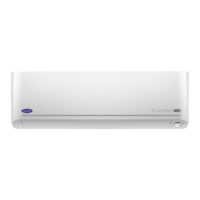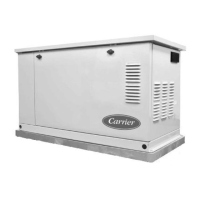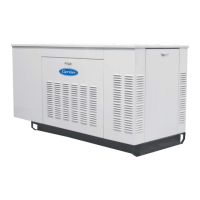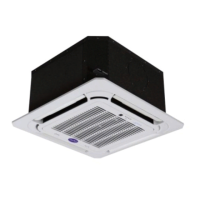4−6
T-343
b. Winding Insulation Testing
Continuity test results for the stator winding tests are
provided in the following table:
Wire
Pair
Ohm*
Wire
Pair
Ohm*
Wire
Pair
Ohm*
T10-T1 I T1-T8 I T4-T5 I
T10-T2 I T1-T9 I T4-T6 I
T10-T3 I T2-T3 I T4-T7 I
T10-T4 I T2-T4 I T4-T8 I
T10-T5 I T2-T5 0 T4-T9 I
T10-T6 I T2-T6 I T5-T6 I
T10-T7 0 T2-T7 I T5-T7 I
T10-T8 0 T2-T8 I T5-T8 I
T10-T9 0 T2-T9 I T5-T9 I
T1-T2 I T3-T4 I T6-T7 I
T1-T3 I T3-T5 I T6-T8 I
T1-T4 0 T3-T6 0 T6-T9 I
T1-T5 I T3-T7 I T7-T8 0
T1-T6 I T3-T8 I T7-T9 0
T1-T7 I T3-T9 I T8-T9 0
* 0 = no resistance (closed circuit) & I = infinite resistance (open circuit)
c. Diode Testing
The rectifier diode assemblies can be tested, and if
damaged, replaced. Over current, over voltage, over
speed, or reverse currents can damage the assembly or
diodes. To remove the diode assemblies and perform
diode testing, do the following:
1. Remove the bearing cover by removing the four bolts
(see Figure 4-8). Both the bearing and diode assem-
blies will be visible.
2. Mark and disconnect the alternator rotor wires at the
rectifier screw terminals. Note that the terminals are
marked with red paint for the forward diode assembly
and black for the reverse diode assembly. Mark and
disconnect the exciter leads from the double spade
terminals (see Figure 4-7).
a.
d.
c.
b.
a.
b.
d.
a. Diode Assembly
b. Diode Bridge
c. Exciter Rotor Lead Connection
d. Alternator Rotor Lead Connection
Figure 4-7 A-C Generator Rectifier Assembly
3. Remove the two cap screws that secure each diode
assembly to the exiter. Once this procedure is com-
plete, the diode assemblies are free for removal.
4. A forward diode should have a low resistance when
the + of an ohm meter is connected to the exciter ro-
tor lead connection (anode) and the - to the diode
bridge (cathode), and a high resistance when the po-
larity of the ohmmeter is reversed.
5. A reverse diode should have a high resistance when
the + of an ohm meter is connected to the exciter ro-
tor lead connection (anode) and the - to the diode
bridge (cathode), and a low resistance when the po-
larity of the ohmmeter is reversed.
6. If both resistances are high or both are low, the diode
is defective and the diode assembly should be re-
placed.
4.5.3 Bearing Replacement
When operated under normal conditions,
factory−lubricated shielded bearings will normally
provide years of trouble−free service. Excessive
bearing load and adverse environment conditions will
greatly shorten bearing life. To remove the bearings, do
the following:
a. Remove bearing cover and mylar gasket. (See
Figure 4-8).
b. Remove bearing with a bearing or wheel puller.
c. Install new bearing. Ball bearings are pre-lubricated
and require no additional lubrication for the life of the
bearing.
d. Coat mating surface of bearing cover flange with
anti-corrosion compound (Tef-Gel, Carrier Part
Number 02-00083-00).
e. Replace bearing cover and mylar gasket.
a.
h.
g.
e.
d.
c.
b.
f.
a. Rectifier Flange
b. Rectifier Assembly
c. Rectifier Bolt
d. Bearin
Cover
e. Bearing Cover Bolt
f. Mylar Gasket
g. Bearing
h. Bearin
Cover Flan
e
Figure 4-8 Rectifier Removal

